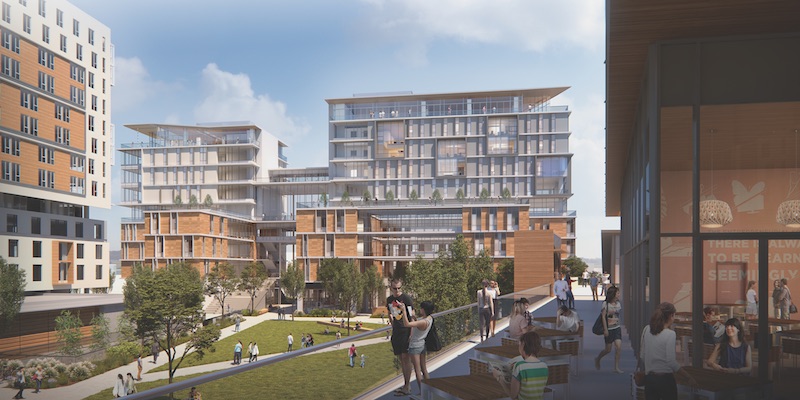Project teams are finding innovative ways to implement smart building technology. New partnerships are one avenue, says Matthew Toner, CBRE’s Managing Director of Smart Buildings and IoT, describing CBRE’s acquisition of Johnson Controls’ Global Workplace Solutions unit. “We’re innovating in proprietary solutions when a client needs a certain product that is not available on the market,” he says.
Edge Technologies has entered into alliances with the International WELL Building Institute and wellness-focused real estate developer Delos. These collaborations, says Executive Managing Director Jan-Hein Lakeman, will help analyze data from its latest smart projects in new ways while giving those organizations access to important post-occupancy information at scale. Edge has identified 13 U.S. cities as targets for new development.
The first of those, designed in collaboration with Perkins+Will, repositions a suburban New Jersey office park into a “connected campus” and headquarters for consumer goods maker Unilever. The building’s 15,000 installed sensors measure temperature, illumination, carbon dioxide, and humidity—a suite of smart tech solutions credited with cutting energy bills by 50% since startup in 2018.
In Denver, WSP’s new innovation center employs digital twin modeling programs to monitor building performance live in the virtual world. The eventual goal: Adjustments made in the VR model will push back into the actual operational model. “This is a great benefit,” notes WSP SVP Herbert Els. “We are looking at continual commissioning and engagement with clients, long after occupancy.”
This idea of “living labs” has also taken hold at HKS Architects, where Tommy Zakrzewski, PhD, Director of Integrative Energy Engineering, uses similar digital twin-modeling concepts to understand how well the firm’s new Chicago office operates, a tool that HKS can apply to client projects.
“Tied to a LEED energy-compliance model, we’ve been able to monitor trends and correct building or workspace performance through a front-end dashboard,” says Zakrzewski. “This kind of system is key for observing positive and negative facility performance and exploring new ideas.”
Working with Clark Construction and Safdie Rabines Architects, HKS is employing these ideas to create a new connected community at the University of California, San Diego’s new North Torrey Pines Living and Learning Neighborhood (see HKS rendering above). A 10-acre interdisciplinary environment blending academic, residential, commercial, and cultural programming, the project seeks to optimize the performance of six different buildings, showcasing “how architecture, engineering, and sustainability come together in a holistic way,” says Zakrzewski.
Related Stories
Smart Buildings | Jul 25, 2024
A Swiss startup devises an intelligent photovoltaic façade that tracks and moves with the sun
Zurich Soft Robotics says Solskin can reduce building energy consumption by up to 80% while producing up to 40% more electricity than comparable façade systems.
Codes and Standards | Jul 25, 2024
GSA and DOE select technologies to evaluate for commercial building decarbonization
The General Services Administration and the U.S. Department of Energy have selected 17 innovative building technologies to evaluate in real-world settings throughout GSA’s real estate portfolio.
Great Solutions | Jul 23, 2024
41 Great Solutions for architects, engineers, and contractors
AI ChatBots, ambient computing, floating MRIs, low-carbon cement, sunshine on demand, next-generation top-down construction. These and 35 other innovations make up our 2024 Great Solutions Report, which highlights fresh ideas and innovations from leading architecture, engineering, and construction firms.
Building Technology | Jun 18, 2024
Could ‘smart’ building facades heat and cool buildings?
A promising research project looks at the possibilities for thermoelectric systems to thermally condition buildings, writes Mahsa Farid Mohajer, Sustainable Building Analyst with Stantec.
Concrete Technology | Jun 17, 2024
MIT researchers are working on a way to use concrete as an electric battery
Researchers at MIT have developed a concrete mixture that can store electrical energy. The researchers say the mixture of water, cement, and carbon black could be used for building foundations and street paving.
Contractors | Jun 4, 2024
Contractors expect to spend more time on prefabrication, according to FMI study
Get ready for a surge in prefabrication activity by contractors. FMI, the consulting and investment banking firm, recently polled contractors about how much time they were spending, in craft labor hours, on prefabrication for construction projects. More than 250 contractors participated in the survey, and the average response to that question was 18%. More revealing, however, was the participants’ anticipation that craft hours dedicated to prefab would essentially double, to 34%, within the next five years.
MFPRO+ New Projects | May 29, 2024
Two San Francisco multifamily high rises install onsite water recycling systems
Two high-rise apartment buildings in San Francisco have installed onsite water recycling systems that will reuse a total of 3.9 million gallons of wastewater annually. The recycled water will be used for toilet flushing, cooling towers, and landscape irrigation to significantly reduce water usage in both buildings.
HVAC | May 28, 2024
Department of Energy unveils resources for deploying heat pumps in commercial buildings
To accelerate adoption of heat pump technology in commercial buildings, the U.S. Department of Energy is offering resources and guidance for stakeholders. DOE aims to help commercial building owners and operators reduce greenhouse gas emissions and operating costs by increasing the adoption of existing and emerging heat pump technologies.
Building Tech | May 21, 2024
In a world first, load-bearing concrete walls built with a 3D printer
A Germany-based construction engineering company says it has constructed the world’s first load-bearing concrete walls built with a 3D printer. Züblin built a new warehouse from a single 3D print for Strabag Baumaschinentechnik International in Stuttgart, Germany using a Putzmeister 3D printer.
Codes and Standards | Apr 30, 2024
Updated document details methods of testing fenestration for exterior walls
The Fenestration and Glazing Industry Alliance (FGIA) updated a document serving a recommended practice for determining test methodology for laboratory and field testing of exterior wall systems. The document pertains to products covered by an AAMA standard such as curtain walls, storefronts, window walls, and sloped glazing. AAMA 501-24, Methods of Test for Exterior Walls was last updated in 2015.

















